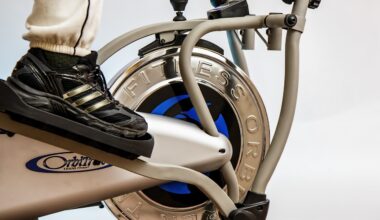Posing Drills to Improve Muscle Control and Definition
Posing techniques are crucial for athletes participating in fitness competitions. Mastering muscle control and definition through effective drills enables competitors to showcase their physique in the best light possible. Various drills focus on specific muscle groups, enhancing the overall presentation. Regular practice can lead to increased confidence while on stage and improve muscle engagement. One essential drill is the “Front Double Biceps” pose, where competitors demonstrate their arm and shoulder musculature. Understanding the mechanics of this pose is vital for optimal effectiveness. Key aspects include proper foot placement, engaging the core, and lifting the ribcage. Moreover, practicing transitions between poses can also enhance fluidity. Training under a mirror allows athletes to observe their angles, ensuring they maintain the necessary structure throughout their performance. A well-rounded posing practice not only assists in achieving a trophy-worthy appearance but also boosts mental preparation. Physical strength alone is not enough; the ability to present that strength can truly elevate an athlete’s performance. Incorporating regular posing practice into your fitness regime will do wonders for muscle control and stage presence.
Another vital drill to improve muscle definition is the “Side Chest” pose. This position is essential for showcasing the upper body, especially the chest and arms. Practitioners should focus on the engagement of the pectorals while simultaneously tightening the biceps. To execute this pose properly, athletes must push their chest out while drawing their arms inward. This action requires a keen sense of body alignment, demanding optimal core engagement. Remember to maintain proper breathing; controlled inhalation and exhalation can significantly impact muscle presentation. Practicing in front of a mirror is advantageous to catch any misalignments or postural issues. It’s advisable to track progress through recordings, enabling athletes to observe gradual improvements. Furthermore, combining this drill with strength training sessions can enhance muscle symmetry. Utilizing resistance bands during practice can supply varying tensions to engage muscles more effectively. Focus on tightening muscles during poses while minimizing any extraneous movements. This drill not only assists in muscle definition but also builds confidence, allowing competitors to own their presentation on stage. Integrating this posing approach into regular training routines can have profound impacts on performance.
Incorporating Dynamic Poses
Dynamic poses can add depth to the routine and allow athletes to show versatility. The “Back Lat Spread” is a prominent example, displaying the width of the lats and overall back aesthetics. Integrating this pose into practice routines enables competitors to highlight their symmetrical physique while ensuring clarity in muscular detail. Consistent practice of this pose promotes muscle memorization, whereby the body instinctively adapits to precise positioning. Focus on breathing and contraction during this pose is vital; it enhances overall effectiveness. Transitioning smoothly into other positions after achieving the “Back Lat Spread” can further enhance the presentation. Rhythm flow between poses can demonstrate poise and confidence. Athletes must engage all major muscle groups, particularly the arms and shoulders, during execution. Consistent training and performance practice can significantly mitigate stage fright. Seeking feedback from coaches or peers can provide valuable insights into refining technique. The ultimate goal is to captivate the audience through strong poses. By practicing these dynamic drills, athletes will ensure they stand out during competitions, showcasing impressive muscle definition and tightness on stage, establishing a strong presence.
Another focus for improvement is the “Abdominal and Thigh” pose. This striking pose showcases core strength and lower body definition, allowing competitors to highlight their abdominal muscles prominently. A precise combination of flexing and body positioning is required to achieve optimal results. Engaging the core while controlling breathing will yield better visibility of muscle definition. Practice this pose regularly to familiarize muscles with the specific angles and body alignments. Body awareness is essential; the better athletes know their own physique’s abilities, the more effectively they can display it. Working in front of a mirror will help determine the angles at which the muscle definition is most pronounced. Transitioning between poses should feel seamless; take time to master the best approach to shift into the next position without losing tension in the muscles. It’s also beneficial to create a routine that incorporates various poses, keeping each session fresh and engaging, preventing plateauing. This exercise sharpens control, enabling competitors to highlight their physical structure most effectively during performances. Ultimately, mastering the “Abdominal and Thigh” pose can significantly elevate a competitor’s stage presence.
The Role of Posture in Posing
Maintaining proper posture is vital in any posing drill. A common mistake is not being aware of how stance impacts overall appearance. Athletes should be conscious of shoulder alignment, foot positioning, and core engagement. Good posture enables better muscle showcase and initiates the body’s natural confidence. Training drills that focus on posture can improve overall performance. Regularly practicing poses like the “Classic Physique” or the “Quarter Turn” can enhance awareness, allowing athletes to refine their positioning. During these drills, competitors should maintain a proud chest, shoulders rolled back, and chin held high to achieve an impressive silhouette. Conditioning sessions should include muscle strengthening activities that fortify core stability. Implementing flexibility and mobility routines can lead to better range of motion during rotation and transitions. Utilizing resistance bands or stability balls can yield significant results, helping create prolonged posture awareness when posing. Searching for feedback is crucial to growth; using mirrors or mirrors as reflection tools can create a more comprehensive understanding of the pose and its requirements. Emphasizing posture alongside muscle control will lead to superior stage presence.
Implementing a variety of drills into practice routines can effectively showcase muscle definition and control. For example, “X-frame” poses can display abdominal structure while emphasizing leg symmetry. Achieving this formation requires practice; attention to small details is essential. Core engagement and proper leg positioning will enhance overall visual appeal. To achieve an X-frame, one must ensure limbs are aligned symmetrically while lifting the ribcage. Observing oneself in the mirror during these poses is vital, allowing for adjustments as necessary. Enhancing leg definition can be accomplished through targeted muscle groups focusing on quadriceps and hamstrings. Regular training of these muscle areas leads to greater muscle engagement when posing. Additionally, weight training and cardio combined with muscle-focused drills create balance within the physique. Improvement in muscle tension and definition will benefit overall presentation on stage. Setting specific goals can provide a clear focus for each training session. Ultimately, mastering these drills will empower athletes to present their unique aesthetics effectively. By showcasing defined physiques, competitors can captivate judges, enhancing their chances of success.
Conclusion: The Path to Posing Mastery
To conclude, mastering posing is an essential aspect of participating in fitness competitions. Regular practice of diverse rehearsals ensures athletes are prepared for various stage scenarios. Each drill contributes to developing muscle control, confidence, and a stunning stage presence. Employing strategies such as recording sessions can provide constructive feedback, enabling competitors to refine their techniques further. Creating a routine that emphasizes posing in harmony with strength training will yield superior results. Furthermore, collaborating with coaches can enhance the learning process by identifying areas for improvement. Most critically, remember that practice makes perfect; continuous dedication to rehearsal will lead to transformations in overall performance. Engaging within a supportive community can also foster motivation and camaraderie. Competitors should seek out peers for mutual encouragement and support. Understanding the importance of muscle control, awareness, and presentation will unify posing efforts through any competition. With diligence, patience, and intentional focus, athletes will elevate their ability to truly shine on stage. Ultimately, success on the competitive platform stems from consistency and a passion for mastering the art of posing.
By embracing these drills, competitors can achieve the peak of their muscular potential, paving the way for fitness success.


